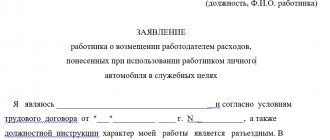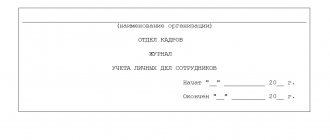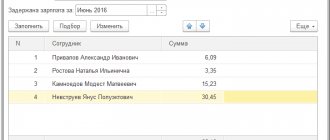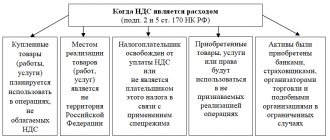Legislative and regulatory acts
The Labor Code of the Russian Federation states that an employee is entitled to compensation for the use of a personal vehicle for the needs of the employer. This is stated in Article 188. Such use can be one-time or on an ongoing basis. Compensation is issued to cover the costs of using the machine. This:
- purchase of gasoline;
- maintenance and repair;
- depreciation.
Such payments do not relate to wages. They have a different purpose that is not related to the employee’s performance of official duties. These payments are designed to compensate for transportation costs incurred by the employee in connection with the performance of work duties. The procedure, amount and terms of payments are fixed in the employment agreement.
Important! The Labor Code stipulates the use of personal transport with the consent of the employer. The presence of such will confirm the concluded agreement between the employee and the organization. It is possible to provide a car for free use at the discretion of the employee.
Accountants who have to conduct settlements with the employee and the tax service, in addition to the Tax Code, should study Government Resolution No. “On establishing standards for organizations’ expenses for the payment of compensation.”
Article 188 of the Labor Code of the Russian Federation “Reimbursement of expenses when using the employee’s personal property”
Decree of the Government of the Russian Federation dated 02/08/2002 N 92 “On establishing standards for the expenses of organizations for the payment of compensation for the use of personal cars and motorcycles for business trips, within which, when determining the tax base for the income tax of organizations, such expenses are classified as other expenses associated with production and sales"
How to apply for compensation for the use of personal transport for an employee
From the article you will learn:
1. What payments are due to an employee in connection with the use of a personal car for business purposes.
2. What documents are used to document the use of personal transport by an employee and the payment of compensation.
We live in an age of speed, so having a car for an employee is often not a luxury, but a production necessity. Many employees have a traveling nature of work (sales managers, sales representatives, field customer service specialists, etc.), that is, the result of their work directly depends on the degree of mobility. However, not every employer has enough resources to provide its employees with company transport, so employees with a personal car are increasingly required. In this article, I propose to figure out how to properly register and compensate for the use of personal transport for an employee. And in the next article we will find out how to take into account compensation amounts for tax purposes and the calculation of insurance premiums.
Grounds for calculating compensation for the use of a personal car
In accordance with Art. 188 of the Labor Code of the Russian Federation, when using personal property, including a personal car, with the consent and in the interests of the employer, the following payments are provided:
— compensation for the use and wear and tear (depreciation) of personal property;
— reimbursement of expenses associated with the operation of personal property.
Compensation for the use of personal transport by an employee is usually set at a fixed amount per month, regardless of the number of calendar days in the month. However, it should be borne in mind that for periods when the employee did not actually perform his official duties (was on vacation, on sick leave, etc.), compensation should not be accrued. As for reimbursement of expenses associated with the employee’s use of personal property in work activities, in the case of the use of personal transport, such expenses may include, for example, the cost of gasoline, car washing, and repairs. According to the Labor Code of the Russian Federation, specific amounts of compensation and compensation, as well as the conditions for their payment to the employee, must be specified in the agreement between the employee and the employer. Thus, we have come close to the issue of documenting the employee’s use of personal transport for business purposes.
To accrue compensation to an employee for using a personal car for business purposes and reimbursement of expenses associated with such use, the following documents are required:
1. Local regulatory act of the organization , according to which the employer establishes the traveling nature of work for certain positions, criteria for the traveling nature of the work of employees, general conditions for calculating compensation and reimbursement of expenses. For example, such documents may include the Regulations on the traveling nature of work, the Order of the manager on approval of the list of positions with a traveling nature of work.
Since the legislation does not define what a traveling nature of work is, the employer must independently establish criteria for the traveling nature of work. Thus, the Regulations can state that “a traveling nature of work is considered to be in which an employee spends more than 5 hours during the working day traveling outside the employer’s territory” or “with a traveling nature of work, an employee regularly performs his official duties (at least 7 times during the working week) travels outside the employer’s territory.” It is advisable to approve the list of positions with a traveling nature of work by a separate order, since the list can be periodically replenished or changed, and issuing a new Order is easier than making changes to the entire Regulation.
! Please note: the traveling nature of the work involves regular trips by the employee in the performance of his work functions, and not one-time trips. That is, business trips once a month cannot be regarded as a traveling nature of work. An indication of the traveling nature of the work must be contained in the employment contract with the employee.
2. Job description of the employee.
The job description must clearly state job responsibilities that require regular travel. For example, duties such as visiting clients to troubleshoot problems (installation, configuration, etc.), visiting potential clients for negotiations (product demonstrations, concluding contracts), delivering correspondence to counterparties and other duties.
3. Agreement between the employee and the employer on the use of personal transport for business purposes.
Such an agreement may be contained in an employment contract, or it may be drawn up as a separate additional agreement to the employment contract. I recommend the second option, since the terms of the agreement may change (when buying a new car, when changing the amount of compensation or the amount of reimbursement of expenses), and in this case it is much more convenient to simply make a new additional agreement than to make changes to the clauses of the employment contract.
The Agreement on the Use of a Personal Car for Business Purposes must include the following information:
- Characteristics of the vehicle (vehicle type (passenger car, truck), make, year of manufacture, registration plate, engine displacement and other essential characteristics);
- Amount of compensation;
- Expenses that are subject to reimbursement, their amount (or calculation procedure) and confirmation procedure;
- Procedure and terms for payment of compensation and reimbursement amounts.
A copy of the vehicle’s passport and a copy of the vehicle’s state registration certificate must be attached to the Agreement. If an employee drives a car that does not belong to him by right of ownership, in addition to the listed documents, a copy of the MTPL policy in which the employee is registered is required.
Download a sample agreement on the use of personal transport for business purposes
4. Order from the manager establishing compensation for the use of personal transport and the procedure for reimbursement of expenses associated with its use.
The order is drawn up on the basis of the Agreement on the use of personal transport for official purposes, assigns responsible persons and serves as the basis for the calculation and payment of compensation and reimbursement of expenses to the employee.
Download a sample order for reimbursement of expenses in connection with the use of personal transport
5. Documents confirming the employee’s actual use of personal transport for business purposes and the amount of expenses incurred during such use. There are no standardized forms of such documents that are mandatory for use, so the employer has the right to independently develop and approve them.
For example, the actual use of personal transport by an employee in work activities can be served by a waybill (according to the employer’s form), or a record of the employee’s travel for official purposes. The main thing is that these documents contain the following information:
- information about the employee and the vehicle (based on the Agreement);
- information about the route indicating destinations and mileage. The route must clearly indicate the business nature of the trips.
To reimburse an employee for expenses associated with operating a personal vehicle for business purposes, documents are required confirming the following expenses:
- gas station receipts, checks or receipts for car washing services, repair work, etc.;
- calculation of expenses incurred in monetary terms. For example, fuel consumption will be calculated based on documented mileage, the price indicated on receipts, and fuel consumption standards approved in the Agreement on the Use of Personal Transport for Business Purposes.
The availability of the documents listed above is a necessary and sufficient condition for the calculation and payment of compensation to an employee for the use of personal transport for business purposes. In addition, proper documentation will allow you to avoid claims from the tax inspectorate and extra-budgetary funds. Read about how compensation for the use of personal transport by employees is assessed with insurance premiums and personal income tax in the following article.
Legislative regulations:
Labor Code of the Russian Federation
All Codes of the Russian Federation are published on the Official Internet portal of legal information https://pravo.gov.ru/
Coverage Agreement
This document is drawn up in the interests of the employee. It confirms the agreement between him and the employer. The document reflects the following information:
- machine characteristics;
- amount and timing of payments.
Sometimes employers do not offer to draw up an agreement, making do with drawing up an order. The employee must read the order against signature. It is preferable to draw up an agreement. This document will help protect the rights of the employee in the event of controversial situations.
Sample agreement to cover expenses for the use of a personal car
When drawing up a written agreement, it is important to indicate the amount of compensation and its type. A separate line includes payments that compensate for the costs of gasoline and maintenance. The legislation does not provide for standards stipulating the amount of compensation. These issues are resolved individually at the enterprise. The Ministry of Finance and the tax services recommend taking into account the frequency of use of the vehicle when making calculations.
Read also: Revaluation of fixed assets
When calculating tax payments, the period of use of the car and how worn it is are taken into account. Examples you can take as an example:
- The amount of payments is calculated based on the average cost of payment for 1 km of taxi accepted in the city.
- Take the calculated amount of depreciation charges as a basis.
Important! You can roughly calculate the amount of depreciation by dividing the market value of the car by its useful life.
Is it possible to compensate for employee travel to and from work?
The law does not oblige the employer to reimburse employees for travel expenses to and from work. Accordingly, if you decide to pay such compensation, it is established voluntarily. This means that it is not subject to those “preferential” rules for personal income tax and insurance contributions that apply to compensation paid by law. If the amount of compensation is fixed, then it will be part of the salary and travel documents will not be needed. If the terms of the contract indicate a payment in the amount of travel expenses incurred by the employee to travel to and from work, then the accountant will have to collect travel documents or checks from the employees.
Example 2 . Compensation for travel expenses to and from the office
Vasilek LLC applies the simplified tax system with the object “income minus expenses”. The terms of the employment contract with manager O.A. Savelyev is provided with payment of compensation for travel to the office and back in a personal car. The amount of compensation is determined in the amount of the cost of gasoline consumed by him, but not more than 3,000 rubles. per month. February 29, 2012 O.A. Savelyev submitted cash register receipts to the accounting department confirming the purchase of gasoline in the amount of 2,800 rubles. On March 1, 2012, the employee received compensation.
Travel compensation is provided for by the terms of the employment contract, so it can be included in labor costs. The cost of gasoline consumed in February is 2800 rubles, which is less than 3000 rubles, therefore, the amount of compensation is 2800 rubles.
When paying compensation, personal income tax must be withheld from it, since it is taxable. Let's assume that O.A. Savelyev has no minor children and is not entitled to other deductions. Then the personal income tax amount will be 364 rubles. (RUB 2,800 x 13%), and the amount of compensation minus taxes is RUB 2,436. (2800 rubles - 364 rubles). Also, insurance contributions to extra-budgetary funds and to the Social Insurance Fund in case of injury must be calculated for the amount of compensation.
On March 1, 2012, the company has the right to include in expenses the compensation paid without personal income tax and the personal income tax transferred to the budget. Insurance premiums calculated on the amount of compensation will reduce the tax base after they are paid.
Essence of the question. If compensation is established in the form of a fixed amount, then when paying it, personal income tax should be withheld and insurance premiums charged.
Nuances that require special attention. According to the Russian Ministry of Finance, compensation paid to employees with a traveling nature of work as required by law are not included in labor costs.
When paying an additional payment for travel in a fixed amount, you will have to pay personal income tax and insurance premiums. Since such a payment will already be an element of the remuneration system.
If the employer pays compensation for the employee’s travel to and from the place of duty on his own initiative, expenses can be taken into account under the simplified tax system, but the employee has income subject to personal income tax.
L.A. Maslennikova
K. e. n.,
expert of the magazine "Simplified"
Subarticle 212 Other payments
This subsection of KOSGU includes expenses incurred in accordance with the legislation of the Russian Federation for the payment by the employer in favor of workers (employees) and (or) their dependents of additional payments, benefits and compensations not related to wages, due to the conditions of labor relations, the status of workers (employees) , including:
(edited)
What does employee car compensation consist of?
The amount must cover the employee’s expenses for:
- depreciation;
- fuels and lubricants;
- Maintenance.
When calculating the amount of compensation, tax authorities recommend taking into account the following parameters:
- degree of wear;
- period of use;
- frequency of use.
Important! When calculating the amount of compensation, you should take into account how many days per month the employee uses the machine. If daily, then it would be wiser to set a fixed payment. For irregular use, the amount may be floating, depending on the number of days of use.
Types of costs compensated to the employee
The Labor Code of the Russian Federation determines the possibility of paying compensation for wear and tear of a vehicle and paying for current expenses for operating a personal car in exchange for:
- Carrying out routine repairs.
- Expenses for the purchase of fuel and fuels.
- Payments for parking during the work shift, car washing.
- Other costs incurred during operation.
According to the tax authorities, the amount of compensation includes wear and tear of the vehicle, expenses for fuels and lubricants, maintenance and servicing.
The employer can compensate for fuel and lubricants using checks provided by the employee. Expenses for fuel and lubricants are covered by the employer based on the amount of actual costs supported by documents. In tax accounting, the amount of fuel and lubricants costs is not taken into account. For payments, it is necessary to determine the mileage, use consumption standards in accordance with the regulations of the Ministry of Transport or technical documentation of transport.
The employer only covers expenses associated with wear and tear and current expenses for using the employee’s personal transport; no payment is made for operating the equipment. The employee operates the equipment as part of his job duties, for which payment is made through wages. Read also the article: → “Accounting for car rental from individuals, legal entities and in other cases.”
Determining the amount of compensation
Accountants who calculate and transfer compensation to an employee will take into account the amount of payments specified in the agreement.
Documented costs are taken into account. For example, the employment agreement provides for a monthly compensation amount of 6,000 rubles. Gasoline costs are paid separately. The employee provides monthly receipts to the accounting department for the purchase of gasoline at gas stations. Thus, the amount of gasoline costs is added to the monthly payment of 6,000 rubles. The total amount will be transferred to the employee as compensation.
If there are vacation days in a month, the amount of monthly fixed compensation will be reduced based on the number of vacation days. Compensation will not be paid for the time spent on sick leave.
Can compensation be taken into account in expenses under the simplified tax system?
“Simplers” with the object “income minus expenses” can include in the tax base only those expenses that are mentioned in the list from paragraph 1 of Art. 346.16 Tax Code of the Russian Federation. It does not directly mention travel compensation for workers with a traveling nature of activity. Therefore, the Federal Tax Service of Russia in Letter dated 04.04.2011 N KE-4-3/5226 makes an unambiguous conclusion that such expenses cannot be taken into account.
If the payment of compensation is provided for in the employment contract, then theoretically it can be taken into account as labor costs. The Russian Ministry of Finance once spoke about this option in Letter dated 01.08.2006 N 03-05-02-04/121. However, there are several “buts” against this approach. Firstly, if you recognize compensation as labor costs, it turns out that this is no longer compensation for specific costs, but an additional payment to earnings. And salary taxes need to be calculated from it. Secondly, the financial department itself changed its position, as reported in Letter of the Ministry of Finance of Russia dated December 16, 2011 N 03-11-06/2/174. It says that compensation for travel is provided for by labor legislation and is not related to the wage system. This means that it does not need to be classified as labor costs, and there is no reason to include such amounts in expenses for the simplified tax system.
An important point. Payment for travel can be classified as labor costs if it is provided for in the employment contract, but disputes with tax authorities cannot be ruled out.
Some experts suggest including travel expenses for employees as business trips. At the same time, the employee’s job descriptions do not indicate the traveling nature of the work. However, this method is quite labor-intensive. After all, all trips of employees will have to be documented as business trips: an order will be issued, travel certificates will be issued, etc.
How to confirm compensation
To confirm the legitimacy of accrued compensation, the following documents are provided:
- Agreement between employee and organization. Attached to the employment contract.
- A document confirming the ownership of personal transport.
- Travel and route sheets, magazines.
- Receipts and receipts for the purchase of consumables.
- Methodology for calculating payments.
- Employee reports.
Important! The report forms provided by the employee must be based on the model approved by the head of the organization.
Procedure for reimbursement of travel expenses for employees
12 of the Regulations approved by Decree of the Government of the Russian Federation of October 13, 2008 No. 749). Reimbursement for other travel expenses of the business traveler is not provided. However, expenses for employee travel by public transport during a business trip can be taken into account as part of travel expenses (subclause 12, clause 1, article 264 of the Tax Code of the Russian Federation). These will be additional travel costs. To take these expenses into account for profit tax purposes, provide for their reimbursement in local regulations (for example, in a collective agreement, regulations on business trips in an organization).* In addition, they must be economically justified and documented (clause 1 of Article 252 of the Tax Code RF). A similar position is reflected in letters from the Russian Ministry of Finance dated July 21, 2011.
Tax accounting
Compensations are not subject to personal income tax. This is stated in letter No. 03-04-06/22274 of the Ministry of Finance, Order of Rostrud No. 17-3/B-291.
When calculating income tax, the amount of compensation is partially taken into account. The calculation is carried out using established standards and is “tied” to engine volume:
- 1200 rub. standard for passenger cars with engines up to 2000 cc. m.;
- 1500 rub. standard for an engine over 200 cc. m.
The calculation is the same for organizations with regular and simplified taxation systems.
Read also: Sale of an LLC with debts
The tax service may complain about the inclusion of a fixed monthly payment in expenses and, in addition, payment of expenses for fuel and lubricants. The service considers gasoline costs already included in the monthly fixed payment.
Compensation is reflected in the expense item after it is paid.
You can use an employee’s car for work purposes by concluding a rental agreement. Under such an agreement, only the vehicle is transferred for use; the owner does not provide vehicle maintenance services. The contract is accompanied by a transfer act describing the characteristics and cost of the machine. It is reflected on the company's balance sheet as a leased asset. The fee for use is established by agreement of the parties. It makes more sense to choose hourly rather than fixed payment. This way, the owner will not have to pay for hours of downtime, for example, if the employee is on sick leave or on vacation.
When used on a rental basis, the organization's expenses will include expenses for gasoline and car maintenance, for its repair, washing and parking. All these costs are written off as enterprise expenses. Personal income tax is withheld from the rent; the tenant company is the tax agent. This position is reflected in the letter of the Ministry of Finance No. 03-04-06/33598. But in this case you will not have to pay insurance premiums. After all, contracts for the transfer of property for use are not subject to contributions for injuries and insurance.
Important! If an employee uses a car by proxy, he can rent it out under an agreement with the permission of the owner. To do this, the power of attorney must contain a line stating the person’s right to enter into a lease agreement on behalf of the owner. The owner will receive rental income.
Comparison table on the advantages and disadvantages of renting or compensation
| Comparison | According to the lease agreement | With compensation |
| From a tax perspective | The organization reflects payments under the lease agreement as an expense item. This is relevant both for the simplified taxation system and for the general | The legislation provides standards depending on engine size. Passenger cars are regulated by organizations with both general and simplified taxation systems. For trucks: with OSNO the payment is written off as an expense in full; with a simplified system it cannot be written off as an expense |
| Inclusion of expenses for fuel and lubricants and gasoline in payments | By renting a car, the organization bears the costs of maintenance and the purchase of gasoline and fuels. Therefore, such expenses can be taken into account in expenses | According to the letter from the Ministry of Finance, the amount of compensation already includes the cost of gasoline and fuel. Including such payments in expenses in excess of a fixed rate may lead to questions from the tax authorities. |
| Presence or absence of personal income tax and insurance contributions | Personal income tax must be deducted from rental payments. This type of payment is exempt from insurance premiums | Personal income tax and insurance premiums are not provided. The compensation paid must correspond to the amount specified in the agreement |
| If the employee is not the owner of the vehicle and uses the car by proxy | To draw up a rental agreement, the consent of the car owner is required. If his personal presence is impossible, the user’s power of attorney must indicate the right to conclude a lease agreement | In this case, compensation cannot be included in expenses. In this case, insurance premiums and personal income tax will have to be calculated |
Read also: Calculation of advance payment in 2021
Letter of the Ministry of Finance dated April 20, 2015 No. 03-04-06/22274 “On the exemption from personal income tax for reimbursement of employee expenses associated with the use of his personal property”
Compensation Accounting
Reimbursement of funds is reflected in the expense item on the date of transfer of compensation. Expenses are written off to the same accounts as the employee's salary. (Account 44 - Selling expenses, account 20 - Main production, account 26 - General business expenses).
When the date of the funds transfer does not coincide with its actual payment, a time difference arises. It is recommended to make payments to the employee in the month in which they are accrued. If different amounts appear in tax and accounting records, then an organization that regularly has a difference in the report is charged increased income tax payments in the current period, according to Order of the Ministry of Finance of the Russian Federation No. 114, ed. 12/24/2010.
Example. Company employee compensation
On July 23, 2017, Ibis LLC transferred to the employee’s salary card compensation for the use of his own car in the amount of 4,000 rubles for July 2021. To reflect income tax, the payment was provided according to the standard - 1,500 rubles, because engine capacity of personal vehicles above 2000 cc. The following transactions will be reflected in the accounting:
| the name of the operation | Debit | Credit | Amount, rub. |
| Payment accrued to employee | 73 | 51 | 4000 |
| Compensation is reflected in expenses | 44 | 73 | 4000 |
| Tax liability: (4000 – 1500) x 20% | 99 | 68 | 500 |
Disadvantages of Flat Rate Compensation
It is advisable to establish a single amount of payments for employees whose activities involve regular business trips. If an employee uses a car several days a month, and his compensation remains unchanged, then misunderstandings may arise with regulatory authorities.
If a fixed cost reimbursement is approved for an employee - 3,000 rubles per month, and out of 21 working days, route sheets are drawn up for only 17, then the amount of payment, not subject to personal income tax, is calculated: 3,000 rubles. / 20 x 17 = 2550 rubles. Some representatives of regulatory authorities think so. However, the other side argues that the amount of compensation must be paid regardless of the actual number of days the car is used.
Therefore, it is recommended to provide reimbursement of costs at a fixed rate to employees who regularly use vehicles for official purposes. In other situations, it is better to process payments using waybills and other documents.
Documents for processing compensation
To apply for compensation you will need the following documents:
- A documented agreement that reflects the timing of payment and the amount of compensation. The calculation method can be indicated here.
- Documents confirming that the employee is the owner of the car.
- Order from the boss on the calculation of compensation.
Sample order for compensation - Receipts and checks confirming the amounts declared by the employee. These are receipts for payment for gasoline, receipts for payment for repairs, and others.
The amount of compensation is not limited by law. But the amount that an organization can write off as expenses is limited by regulations.
What documents should I use to submit compensation?
First of all, information that the employee’s work is traveling in nature must be contained in the job description. In addition, the employer’s obligation to compensate the employee for expenses arising during the performance of his work duties must be specified in one of the clauses of the employment or collective agreement. And finally, it is advisable for the manager to issue an order for compensation of expenses, while approving a list of positions whose work involves traveling (an example of an order is given on p.






